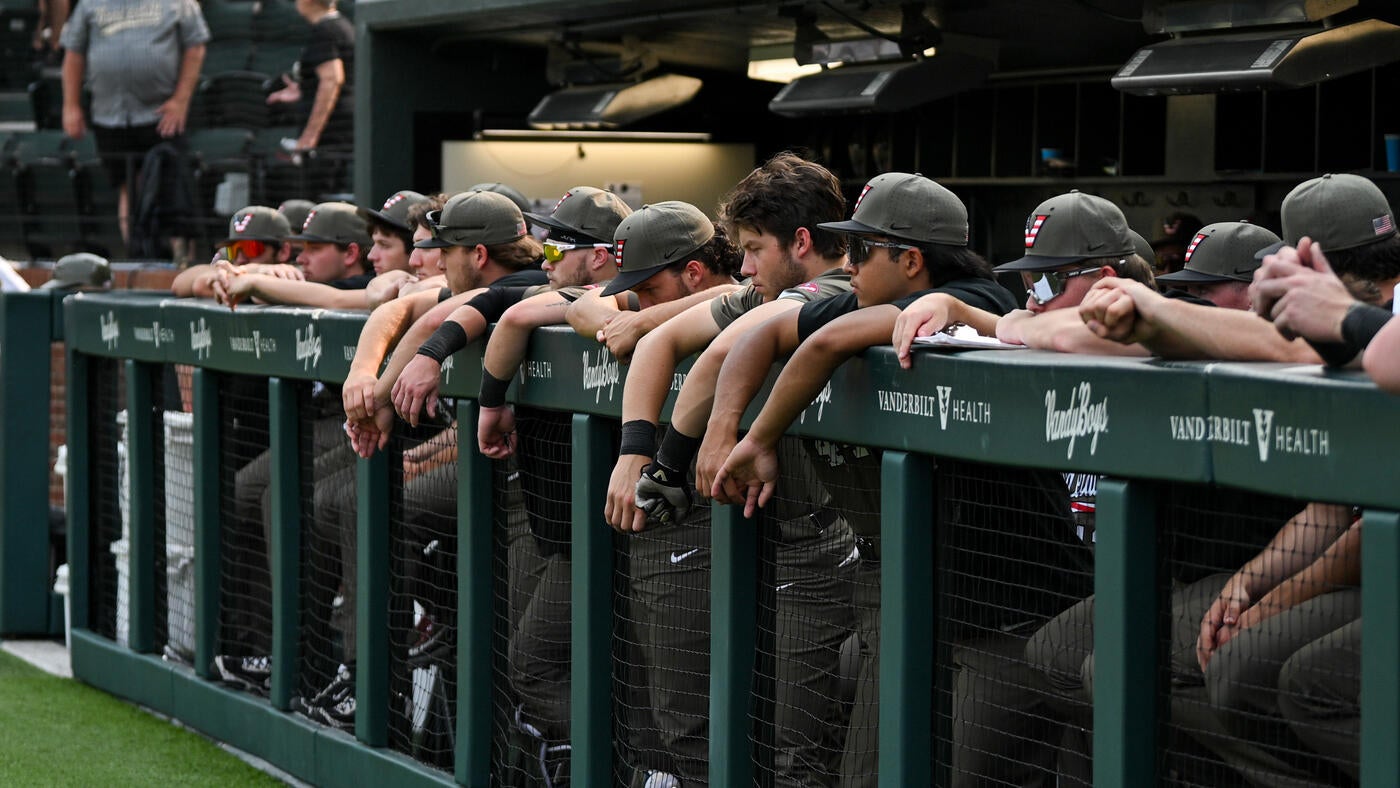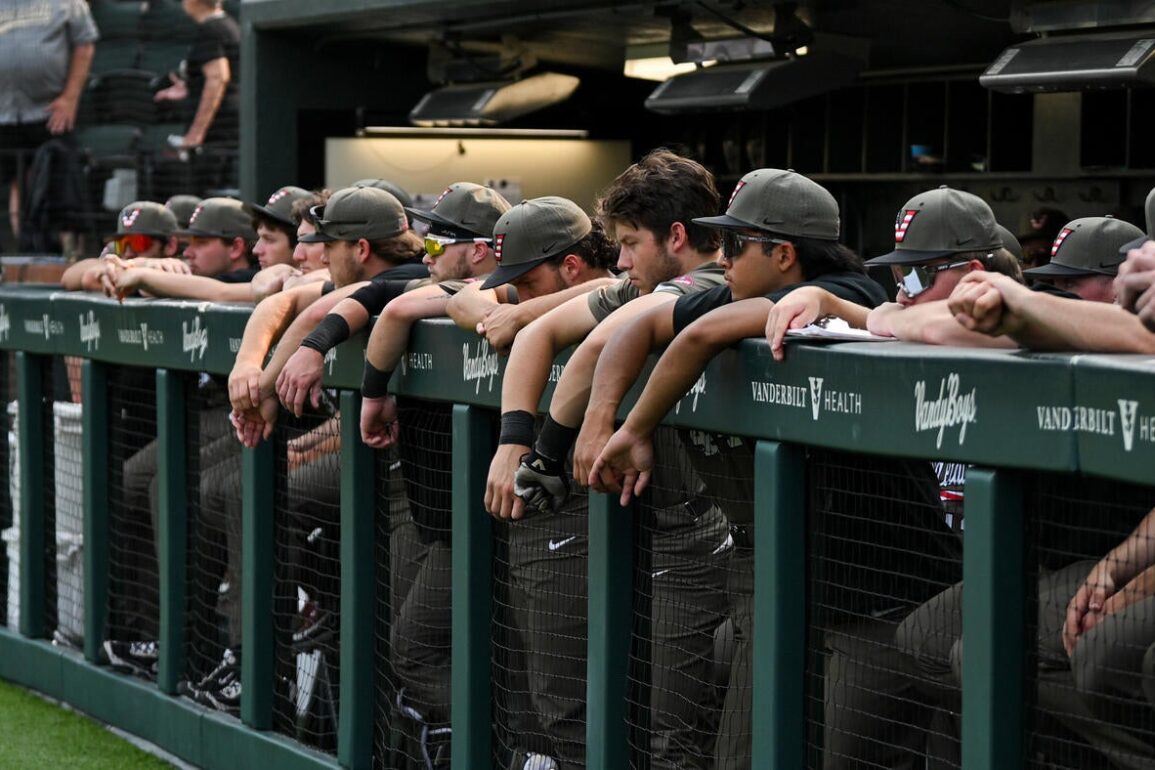Omaha is in sight for the 16 teams remaining in the NCAA Baseball Tournament. After a chaotic regional round that saw each of the top two national seeds eliminated, we’re down to just a quarter of the schools that made the initial 64-team field. This elite handful is set to decide the 2025 College World Series field in the super regional round beginning Friday.
There are plenty of juicy matchups to look forward to. Few, if any, will bring as much drama as the Fayetteville Super between No. 14 Tennessee and host No. 3 Arkansas. The Vols and the Razorbacks have plenty of shared history in the SEC and a ton of talent with bright professional futures.
Elsewhere, No. 9 Florida State travels to Corvallis, Oregon to battle No. 8 Oregon State in a showdown between baseball heavyweights.
NCAA Baseball Tournament: ACC legitimizes threat to SEC supremacy as historic upsets rule regionals
Carter Bahns

All eyes are on a couple non-seeded underdogs in Murray State and UTSA, who stunned their regional hosts in the opening weekend to keep their seasons alive. Teams like Louisville, Miami, Duke and West Virginia also made it out of the proverbial first round without the benefit of hosting.
CBS Sports college baseball experts Will Backus and Carter Bahns teamed up to look at one reason for optimism, and one for concern, for each of the 16 teams in the super regional round.
Auburn Super Regional
No. 13 Coastal Carolina
Optimism: This pitching staff is legit. The Chanticleers have a 3.24 team ERA, which is best among teams left in the tournament, and their starting rotation goes three deep. Jacob Morrison (2.19 ERA) is the ace, but there’s not much dropoff between him and Riley Eikhoff and Cameron Flukey. Coastal also has six relievers that have appeared in at least 15 games with an ERA below 4.00 that can come out of the pen, as well.
Concern: There’s not a ton of pop in the lineup. Coastal Carolina has only hit 62 home runs on the year and has a team slugging percentage of .449, tied with Miami for the worst among teams in the super regional round. The Chants still score a respectable 7.6 runs per game, which is sufficient in most cases, and, as mentioned above, the pitching is more than capable of keeping other offenses in check. But Coastal Carolina does not want to get into a slugfest with Auburn’s lineup.
No. 4 Auburn
Optimism: Auburn’s lineup is a tough out, quite literally. The Tigers have only struck out 422 times this season, the lowest strikeout total among SEC teams, and they’ve walked 280 times. They have smart at-bats and they’re very good at putting the ball in play. That will serve them well against a Coastal Carolina team that has produced 560 strikeouts this season.
Concern: Auburn’s pitching has taken great strides this season — especially compared to where it was in 2024 — but the Tigers are still relatively subpar by SEC standards. They’ve got a team ERA of 4.71. There’s some solid swing-and-miss stuff, and Auburn does do a good job of keeping the ball in the park, but it will be challenged by a Coastal Carolina offense with standouts like Caden Bodine. — Backus
Baton Rouge Super Regional
West Virginia
Optimism: Griffin Kirn could become a household name. Kirn, a product of Quincy University, has quietly been one of the nation’s best pitchers all year. He’s thrown at least seven innings in each of his last four starts — including a complete game in West Virginia’s Big 12 Tournament win against Cincinnati — and has allowed six earned runs while striking out 26 batters in that span. He’ll get tested by LSU, but he’s got what it takes to go deep and keep the Tigers quiet.
Concern: It’s good that Kirn can stretch games out, because WVU’s pitching depth is a bit of a concern. The top of the Mountaineers’ staff is great, especially with arms like Kirn and Jack Kartsonas. But they’re two of just four pitchers (that take the mound regularly) with an ERA below 4.00. This issue becomes especially glaring if the series reaches a third game. West Virginia has allowed an average of 7.5 in Game 3s this season.
No. 6 LSU
Optimism: Kade Anderson and Anthony Eyanson are the most lethal starting duo in the tournament. They’re both top three nationally in strikeouts and neither allowed a single run in their respective regional starts. Anderson torched a really good Dallas Baptist lineup by striking out 11 in seven innings of work.
Concern: If the series gets stretched past Anderson and Eyanson. Without its two aces on the mound, LSU allowed six runs and five runs in the first two innings of its regional final games against Little Rock. The Tigers may have found a legitimate third option in freshman Casan Evans, who turned in six sterling innings Monday night, but they’d like to shut this series down in two games. — Backus
Chapel Hill Super Regional
Arizona
Optimism: Getting away from cavernous Hi Corbett Field is often a boon to Arizona pitching. Nobody could have seen this breakthrough coming for the staff over the last six games away from home, though. Wildcat hurlers surrendered just nine combined runs in the Big 12 Tournament and Eugene Regional and no more than four in a single contest. If that somehow sustains, it could surprisingly carry an inconsistent offense to Omaha.
Concern: If the season ended today, this offense would go down as the second-lowest scoring unit at Arizona since 2018. The bats are hot right now and mashed 15 homers in the regional (including eight in the finale, three of which came from Mason White), but that also came against the No. 3 and No. 4 seeds. Can they keep it going against a terrific UNC staff?
No. 5 North Carolina
Optimism: Oklahoma coach Skip Johnson said after North Carolina’s regional win that “you guys have a team here that can win the national championship.” It is hard to disagree with him. The way freshman pitchers Walker McDuffie and Ryan Lynch have delivered to complement a stout staff, plus the mammoth 13-for-18 start to the tournament from Gavin Gallaher, are just a couple of reasons why the Tar Heels are the top-ranked squad in the polls.
Concern: There is not much to nitpick in a team that has not lost consecutive games since March 19. If UNC has a vulnerable spot, it is when opponents throw their best arms, as that is essentially the only thing that has been able to keep the Tar Heels in check. They will face a lot of top-flight pitching the rest of the way. — Bahns
Corvallis Super Regional
No. 8 Oregon State
Optimism: The offense is on an absolute tear, and it got production in the regional round from a couple of bats that had underwhelmed for much of the regular season. Trent Caraway homered in each of Oregon State’s five games last weekend and Tyce Peterson carried the bottom of the order with a huge regional before he missed the finale with an undisclosed injury. After outscoring their last four opponents 50-6, the Beavers are as hot as they have been all year.
Concern: Control is a significant issue for the Oregon State pitching staff, and it reared its head in the regional opener as starter Eric Segura plunked a couple of batters and put the Beavers in a hole out of which they could not climb en route to a shocking defeat. The bullpen walks too many batters, too. If anything stops the Beavers from winning a fourth national title, it will be a lack of strikes.
No. 9 Florida State
Optimism: Not many teams boast the same elite combination of starting pitching and batting as Florida State. Everything starts with Jamie Arnold, who has 1-1 potential in July’s MLB Draft with his overpowering lefty arm which befuddled hitters over the last two dominant seasons. Joey Volini is an outstanding No. 2 guy, too. Combine that Friday-Saturday tandem with a lineup that features seven .300 batters (and one .400 hitter in Alex Lodise), and the Seminoles have a complete team.
Concern: The bullpen is not great. Only two relievers compiled ERAs below 4.00 thus far in Joe Charles and Brady Louck, and the latter throws far less often than his counterparts. The Seminole relievers walk too many batters and have blown a few games for the stellar starting rotation. That is a fine line to walk in the postseason. — Bahns
Durham Super Regional
Murray State
Optimism: Murray State has plenty to prove. Motivation and momentum matter in baseball, and the Racers have both in spades. They walked into Ole Miss’ stadium and beat the Rebels twice to make it out of the regional round, yet plenty of people still doubt their ability to go any deeper. They were also able to weather the storm against an Ole Miss team that nearly rallied from a 12-3 deficit in Monday’s game to pull the rug out from Murray State. This team is battle-tested and it won’t be daunted from such a pressure-filled environment.
Concern: Murray State’s pitching may not be strong enough. The Racers don’t have a single pitcher who averaged 92-plus MPH on their fastball this season. The bats came alive in the Oxford Regional, but the Racers did allow 41 runs in their last three games. That’s not necessarily sustainable.
Duke
Optimism: Duke has that clutch gene. The Blue Devils employed timely hitting plenty throughout the Athens Regional. They plated two runs in the ninth inning to secure a Game 2 win against Georgia and then plated three decisive runs in the bottom of the eighth inning in their regional final win against Oklahoma State. Murray State advanced, in part, because teams it faced were unable to capitalize in crucial situations. That shouldn’t be a problem for Duke, if such situations arise.
Concern: AJ Gracia’s suspension. One of Duke’s best hitters will miss the first game after he was (controversially) ejected in the Blue Devils’ regional final win against Oklahoma State for exiting the dugout with a home run prop in his hands. It’s just one game and Duke has some solid options to replace him, but his absence is Duke’s most glaring concern entering the weekend. — Backus
Fayetteville Super Regional
No. 14 Tennessee
Optimism: The bats are hitting their stride. Tennessee’s offense struggled with inconsistency all year, but the Vols showed major improvement in their regional. They scored at least six runs in all four games. Gavin Kilen and Andrew Fischer are reliable stars, but Tennessee should be optimistic that Dean Curley is turning a late corner after a down year. He had four hits, six RBI and a home run in the last three games of the Knoxville Regional.
Concern: The bullpen. Infield defense also needs to be much better. Tennessee has two of the nation’s top starters in Liam Doyle, the 2024 SEC Pitcher of the Year, and Marcus Phillips, who has nasty stuff. Things get sketchy after that. Options like Brandon Arvidson and Nate Snead can eat up innings out of the pen, while AJ Russell provides flexibility as a potential third starter or stretch reliever. They’ll all need to be better against a complete Arkansas lineup, though. The defending national champion Vols are currently +650 to repeat, according to FanDuel Sportsbook — tied for the third best-odds behind LSU (+310) and Arkansas (+380).
No. 3 Arkansas
Optimism: The batting lineup is absolutely stacked. Wehiwa Aloy gets a lot of the focus as the SEC’s Player of the Year, but the Razorbacks roll nine deep. They’ve got six consistent starters with a batting average above .300 and seven hitters have knocked at least 12 home runs out of the park. Pitchers have to be on top of their game against Arkansas’ entire order.
Concern: The starting pitching has been a bit shaky lately. Now, Arkansas didn’t labor much in the Fayetteville Regional, but between April 1 and the start of the NCAA Tournament — the heart of SEC play — Arkansas’ weekend rotation boasted an ERA of 5.88. They also averaged fewer than four innings per start. That won’t cut it against a Tennessee team that is hitting its stride offensively. — Backus
Los Angeles Super Regional
UTSA
Optimism: The Roadrunners had no issues going up against outstanding pitchers in the Austin Regional, as they scored at least seven runs in each of their three contests. Perhaps it should not have come as a surprise given that UTSA ranks seventh nationally in runs scored. The lineup is incredibly deep, and it is remarkably skilled at getting on base with the nation’s 10th-best OBP at .428. Opponents have to hit and hit well to keep up.
Concern: UTSA is offense-reliant, which works when you score more runs than nearly any other team in college baseball. It could catch up to the Roadrunners as they face more capable opponents, though. Their starting pitchers hover around the 4.50-5.00 ERA range and often force the bats to do the heavy lifting. In their 13 losses, Roadrunner opponents scored at least five runs all but one time.
No. 15 UCLA
Optimism: Big Ten Player of the Year Roch Cholowsky anchors an explosive offense that led the conference in scoring by a wide margin. UCLA just flat out hits, and its 38 runs across three games in the Los Angeles Regional made it no sweat to advance to the next round. The Bruins flexed their ability to take control of games early as Cholowsky logged a pair of two-hit games and Roman Martin contributed a pair of home runs.
Concern: John Savage produces elite pitchers like hardly any other coach in college baseball, but he uncharacteristically lacks the same kind of weapons this season. The strikeouts have not been there, Ian May did not take the leap many hoped he would upon his transfer from California, Michael Barnett fell off a bit after a hot start to the year and Sunday starter Landon Stump has not been able to keep men off the bases. — Bahns
Louisville Super Regional
Louisville
Optimism: The résumé, at least on the high end, looks like that of a CWS team. Louisville took series against North Carolina and Florida State, logged a two-game season sweep of Vanderbilt and defeated multiple other ranked opponents. That made the Cardinals as dangerous of non-regional hosts as there were last weekend, and they delivered with a quick sweep of the field. They consistently prove their high upside.
Concern: Pitching was far from an issue last weekend, but that was a step away from the norm. Despite his great strikeout stuff, Patrick Forbes holds just a modest 4.62 ERA and leads the rotation in run prevention with that mark. The third starter role has been in flux all year, too. The back end of the Cardinals’ bullpen is a redeeming factor, but far too often have the rest of the arms put them in deep holes.
Miami
Optimism: Miami has been a streaky team this year and seems to be on one of its upswings. Wins and losses come in bunches, and after they closed the regular season with six losses in seven games, the Hurricanes looked in the Hattiesburg Regional like the version of themselves that ripped through the ACC in April. Getting hot at the right time is sometimes all it takes to mask underlying issues and punch a ticket to the CWS.
Concern: Last Sunday’s 17-6 loss was an example of how things have a tendency to get away from the Hurricanes. It was a huge issue early in the year, settled down for much of the spring and cropped back up over the last month. Miami pitchers surrendered double-digit runs at least once in each of the last four weeks, and now entering the supers, only three arms on the entire staff hold ERAs below 4.00. — Bahns
This post was originally published on this site be sure to check out more of their content.






